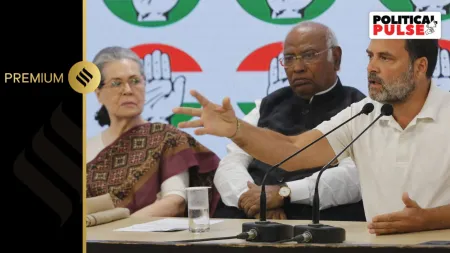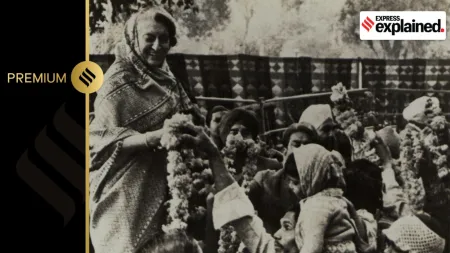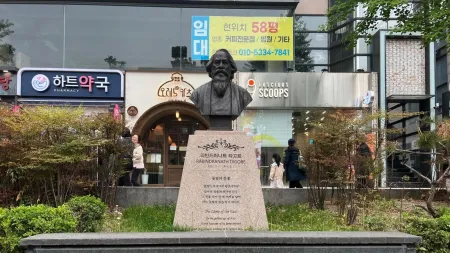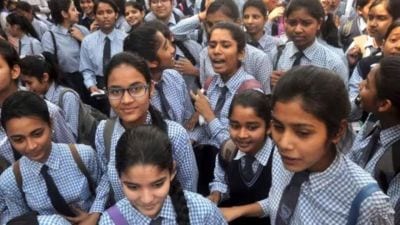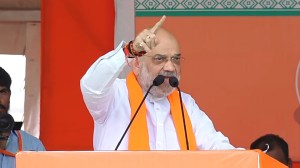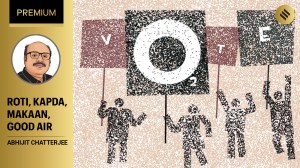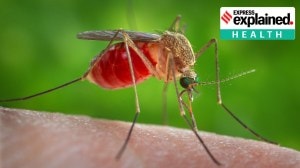- India
- International
Rajasthan harvests despair: No takers for poor quality rabi crop
Farmers take their produce to the mandis but rates offered by middlemen are so low that many return with their produce.
 Bhagwan Sahay Meena in his field. (Source: Express Photo by Sweta Dutta)
Bhagwan Sahay Meena in his field. (Source: Express Photo by Sweta Dutta)Huge metal boxes store 20 quintals of barley, 15 quintals of wheat, 10 quintals of mustard and 5 quintals of gram — Bhagwan Sahay Meena’s rabi crop. He lays out some of the yellowing wheat out to dry and tops the metal boxes, stacked in a store room, with neem leaves to keep away insects and to protect the crop from rotting further.
With 25 bighas of irrigated land, Sahay is considered among the more affluent farmers in his village Dhand in Kukas tehsil, about 30 km from Jaipur. However, he too has sought Rs 5 lakh loan to survive the season.
“From whatever we could salvage, the produce is of such poor quality that even my cattle refuses to eat it,” he sighs, pointing to the boxes holding his crop.
Any other year, this would be the season of festivities and weddings in Rajasthan. However, in Dhand, as in village after village across the state hit by unseasonal rains repeatedly and the recent hailstorm, this is an Akshaya Tritiya devoid of pomp and show.
[related-post]
Sahay talks of baraats as well as wedding arrangements seeing a scaling down in size.

Farmers from the village take their produce, predominantly barley, wheat and mustard, to the nearby Chomu and Achrol mandis. Rates offered by middlemen have been so low that many have returned with their produce.
A sack of one-quintal wheat that sold for up to Rs 1,700 last year is fetching them at the most Rs 1,300. Farmers point out that there was already pressure on prices due to the bumper harvest last year, and this year’s crop damage has come atop it.
Still, Sahay is among the luckier ones, as he himself accepts. “I won’t sell my produce till say October-November by when there will be a shortage and buyers will have to pay more. So I have stocked my produce and keep airing and drying it in the sun. I have also applied for a loan of Rs 5 lakh that will see me through this season and take care of sowing the kharif crop,” he says.
Badri Lal Meena can’t afford to take that chance. The owner of 12 bighas of land, he has “almost nothing”. “Crop on only 4-5 bighas could be salvaged and that too is selling at an abysmal rate,” Badri Lal rues.
The government estimates the total rabi crop damage at 45.5 lakh hectares.
The state government announced on Tuesday that it would take on the farmers’ losses and ensure they are paid minimum support price of Rs 1,450 per quintal by Food Corporation of India for wheat without any deduction. It also announced it would pay Rs 7.25 per quintal additionally in case of partially damaged or broken wheat grains assessed in the range of 6 per cent to 9 per cent, and Rs 3.63 per quintal in case of poor lustre ranging from 10 per cent to 50 per cent.
However, as farmers point out, the government is yet to start buying, while FCI norms are so strict that despite concessions, their crops would not meet the criteria.
“If I say even the cattle are refusing to eat them, you can imagine what poor quality these grains must be. If the rain and hailstorm had stopped after one spell it would have still been possible to salvage the crop, but it rained continuously, even after we had harvested,” Sahay says.
There is another problem in getting compensation. While farmers complain that around 50 per cent of their crop is damaged, the local patwari has submitted a report certifying only 10 to 20 per cent crop loss — which excludes farmers from receiving any compensation.
The Vasundhara Raje government had earlier relaxed the state disaster relief fund norms, from 50 per cent crop damage to 25 per cent, for compensation purposes.
The farmers slam the patwari, Santosh Kumar, and complain that local MLA Navin Pilania, of the National People’s Party, did not even turn up for the survey that the state government had asked all legislators to conduct. The Budget Session of the state Assembly had been adjourned for two days so that the MLAs could do a detailed survey of their constituencies and report to the state government.
Farmers at Dhand allege that even Kumar did not turn up for the survey, and made up the figure on the losses.
The patwari, however, insists his report only states what he saw. “The damage is not so much in this region.”
Like in most villages of Rajasthan, Dhand farmers too have fallen back on animal husbandry. Rakesh Meena, who struggled to make ends meet even in good crop years, says he is totally dependent on his cattle after “entire crop loss”.
He has four buffaloes, each of which gives 10 litres of milk per day. “Each litre is sold for Rs 35, so with four buffaloes, I manage to make more than Rs 1,000 per day. But cattlefeed too is expensive and comes for Rs 200-250 per quintal, feeding a buffalo for barely three days,” he explains.
Sahay points out that whenever there is a drought or flood in the area, the milk production in the village goes up drastically. “Families reduce their own consumption and sell it to make money,” he says.
Banks in the vicinity have also noticed a spike in loans. While some of it is due to the wedding season, farmers are also lining up for money to meet losses. Bank of Baroda, Kukas branch, the oldest bank in the area, which has the maximum number of farmer accounts, has seen at least a 20 per cent increase in loan applications.
Branch Manager M P Meena says they have around 700 plus accounts of farmers and had got more than 50 loan applications over the past couple of months with an average request of Rs 2-3 lakh. “If all of them are approved, we will be shelling out around Rs 1.25 crore or so,” Meena says.
Bleak figures
Total damage: 45.5 lakh hectares of rabi crop
Govt relief norms: Relaxed from 50 pc crop damage to 25 pc
Prices down: from Rs 1,700 per quintal last year to Rs 1,300
Govt promise: Rs 1,450 per quintal MSP of wheat
May 09: Latest News
- 01
- 02
- 03
- 04
- 05


